Books
Books
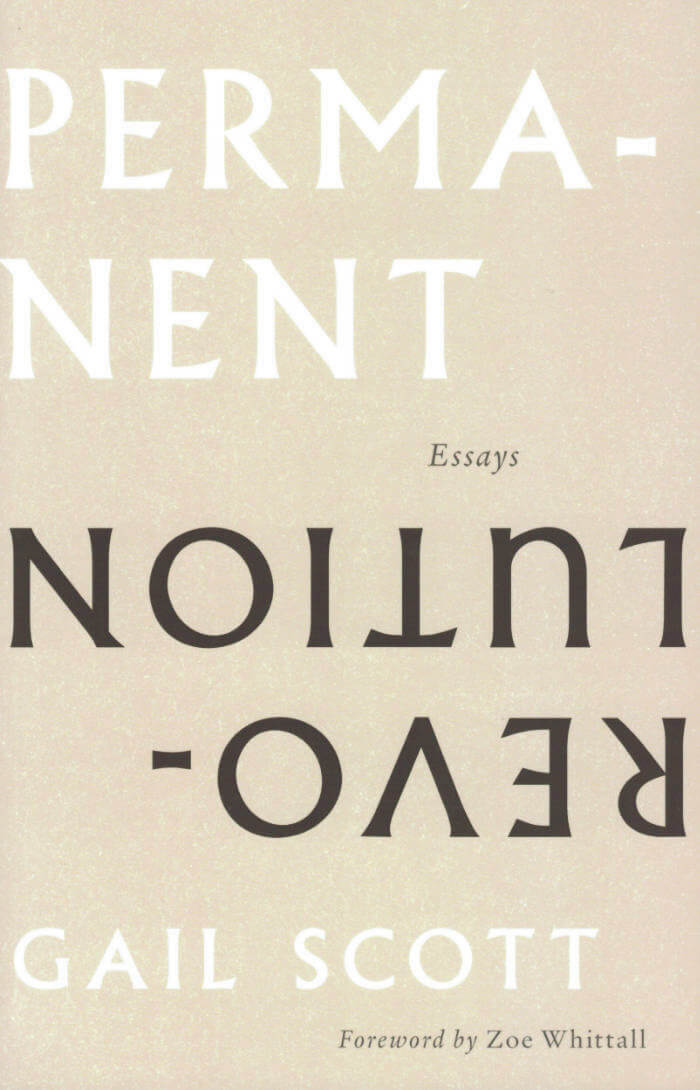
Permanent Revolution: Essays
From iconic feminist writer Gail Scott comes Permanent Revolution, a collection of new essays gathered alongside a recreation of her groundbreaking text, Spaces Like Stairs. In conversation with other writers working in queer/feminist avant-garde trajectories, including l'écriture-au-féminin in Québec and continental New Narrative, these essays provide an evolutionary snapshot of Scott's ongoing prose experiment that hinges the matter of writing to ongoing social upheaval. Scott herself points to the heart of this book, writing, "Where there is no emergency, there is likely no real experiment."
With a Foreword by Zoe Whittall and an Afterword by Margaret Christakos.
Gail Scott is the author of Spare Parts (1981), Heroine (1987, re-issued in 2019 with an introduction by Eileen Myles), Main Brides (1993), My Paris (1999), Spare Parts Plus Two (2002), and The Obituary (2010). Her essays are collected in Spaces Like Stairs (1989) and in La Théorie, un dimanche (1988) which was translated into English as Theory, A Sunday (2013). Scott is co-editor of the New Narrative anthology: Biting the Error: Writers Explore Narrative (2004). Her translation of Michael Delisle's Le désarroi du matelot was shortlisted for a 2001 Governor General's Literary Award. A memoir, based in Lower Manhattan during the early Obama years, is forthcoming. Scott lives in Montréal.
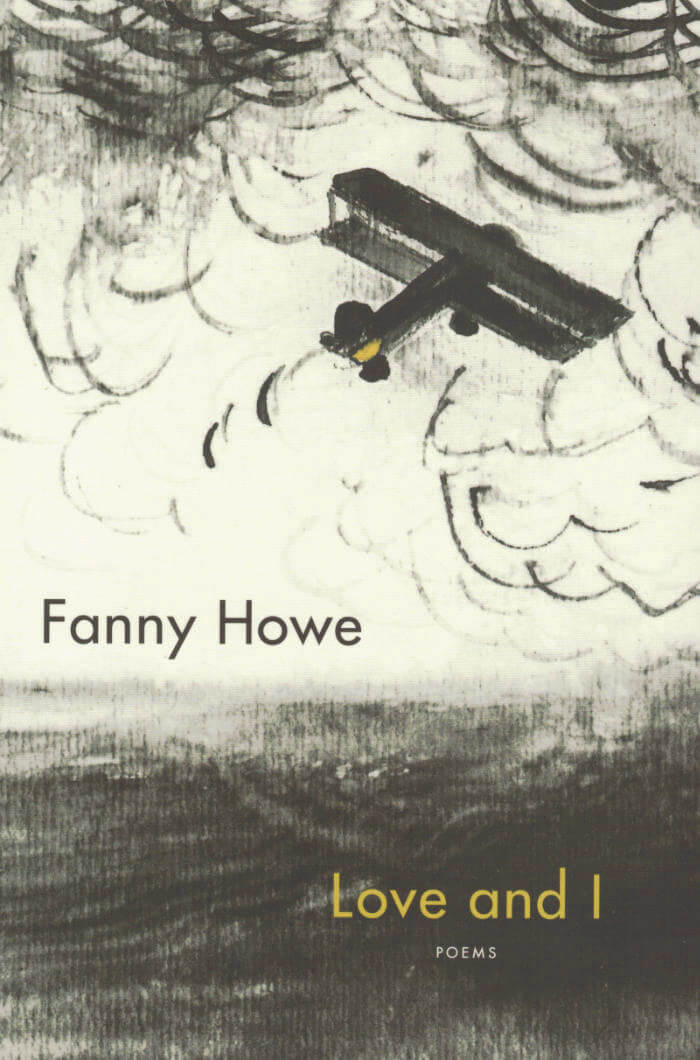
Love and I: Poems
Set in transit even as they investigate the transitory, the cinematic poems in Love and I move like a handheld camera through the eternal, the minds of passengers, and the landscapes of Ireland and America. From this slight remove, Fanny Howe explores the edge of "pure seeing" and the worldly griefs she encounters there, cast in an otherworldly light. These poems layer pasture and tarmac, the skies above where airline passengers are compressed with their thoughts and the ground where miseries accumulate, alongside comedies, in the figures of children in a park.
Love can do little but walk with the person and suddenly vanish, and that recurrent abandonment makes it necessary for these poems to find a balance between seeing and believing. For Howe, that balance is found in the Word, spoken in language, in music, in and on the wind, as invisible and continuous lyric thinking heard by the thinker alone. These are poems animated by belief and unbelief. Love and I fulfills Howe's philosophy of Bewilderment.
"[Love and I] hurries to join a long and illustrious career, which, besides poetry, includes novels, stories, memoir, and short films. . . . Howe prefers the clarity of misunderstanding to the blur of certainty. Like stained glass, her poems await illumination, but it is important not to flood them with a klieg light. . . . It is marvelous to think of these works as having been made not in some bower but in the midst of life." — The New Yorker
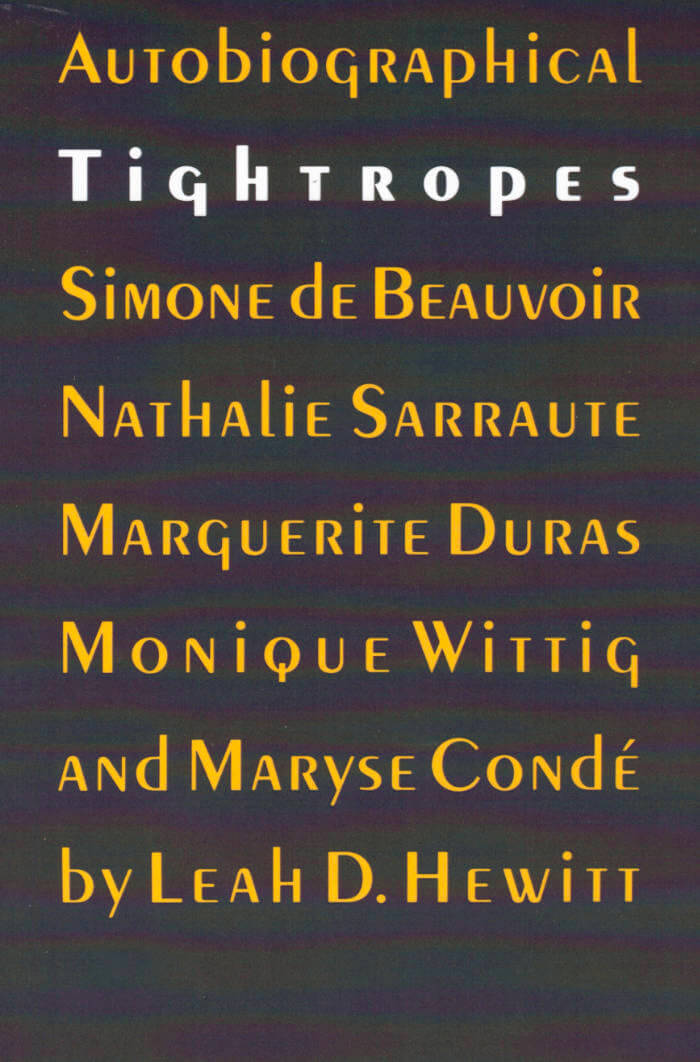
Autobiographical Tightropes
"In order to write" said Simone de Beauvoir, "the first essential condition is that reality can no longer be taken for granted."
She and four other French women writers of the second half of the twentieth century-Nathalie Sarraute, Marguerite Duras, Monique Wittig, and Maryse Condé-illustrate that producing autobiography is like performing a tightrope act on the slippery line between fact and fiction.
Autobiographical Tightropes emphasizes the tension in the works of these major writers as they move in and out of "experience" and "literature," violating the neat boundaries between genres and confusing the distinctions between remembering and creating.
Focusing on selected works, Leah D. Hewitt for the first time anywhere explores the connections among the authors. In doing so she shows how contemporary women's autobiography in France links with feminist issues, literary tradition and trends, and postmodern theories of writing. In light of these theories Hewitt offers a new reading of de Beauvoir's memoirs and reveals how her attempt to represent the past faithfully is undone by irony, by literary and "feminine" detours. Other analysts of Nathalie Sarraute's writing have dwelt mainly on formal considerations of the New Novel, but Hewitt exposes a repressed, forbidden feminine aspect in her literary innovations. Unlike Sarraute, Duras cannot be connected with just one literary movement, political stance, style, or kind of feminism because her writing, largely autobiographical, is marked by chameleon like transformations.
The chapters on Wittig and Condé show how, within the bounds of feminism, lesbians and women of color challenge the individualistic premises of autobiography. Hewitt demonstrates that, despite vast differences among these five writers, all of them reveal in their autobiographical works the self's need of a fictive other. Leah D. Hewitt is an associate professor of French at Amherst College.
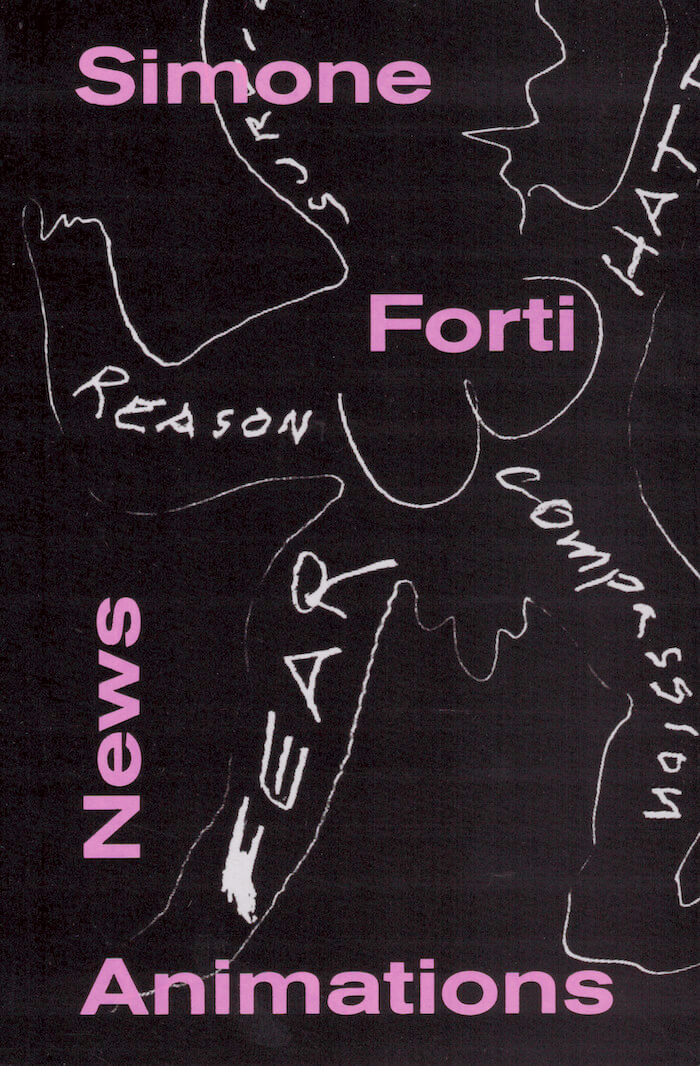
News Animations
A reference book containing all the transcripts of Simone Forti's News Animations.
The book is the complete collection of Simone Forti's News Animations, one of the works that best reveal her artistic practice. The news and, more broadly, the most pressing issues of the global socio-political situation, are used to explore the potential of language, its dimensions, and its combination with dance, movements, words, images, and music. Simone Forti has always "danced" the news, it's the way she tells them. But, above all, it's the way she internalizes them, feels them, and processes them. Through a stream of consciousness, the artist grants voice and body to thoughts about the world, its conflicts, war, injustices, and inequalities.
The volume collects Simone Forti's News Animations from 1980 to 2018—through the transcriptions of the performances, images, and drawings—seeking to capture their spirit, their poetic stance and, mostly, understand how they manage to describe the society and the world we live in.
Introduction by Luca Lo Pinto
Published August 2021

Poems I Will Never Release, 2007-2017
First retrospective monograph: an essential resource for any in-depth critical study of Chiara Fumai's work and thought, including a first systematic analysis of her oeuvre.
This book is dedicated to the complex artistic trajectory of Chiara Fumai, who played a significant role in the development of performance and feminist aesthetics in the twenty-first century and who died prematurely in 2017, at the age of only thirty-nine. Conceived as a critical monograph on Fumai's work as a visual artist, performer, DJ and music curator, Poems I Will Never Release is the first volume to trace the entirety of her artistic path: from her scathing video performances and large-scale installations, to her more intimist practices of automatic writing and collage and her incursions into music.
Almost 500 pages long, the volume is divided into three main chapters. The first of these brings together essays by prominent writers, curators and artists who examine Chiara Fumai's work from various perspectives, highlighting its intersections with anarchism, feminism, ideological forms and discourses of power and oppression, the animal rights movement, theater, surrealism and esotericism. The second chapter presents an imposing iconographic apparatus that documents Chiara Fumai's entire artistic production, from 2007 to 2017, while the third offers an exhaustively detailed chronology and bibliography.
The book collects essays by Irene Aristizábal, Andrea Bellini, Federico Campagna, Milovan Farronato, Francesco Urbano Ragazzi, Mara Montanaro, Chus Martínez, Paulina Olowska and Giovanna Zapperi, as well as conversations between Raimundas Malašauskas and Gabriel Lester, and Cristiana Perrella and Marcello Bellan. The chronology and bibliography are edited by Sara de Chiara.

Fórum do Futuro – Vita Nova
Jenna Sutela, Filipa Ramos and 2 more
A collective book that proposes to question human and non-human existence in the current social context, spanning different cosmogonic views.
The Vita Nova editorial project had its genesis in the Fórum do Futuro: a programme of debates, artist talks, and performances, held annually in the city of Porto, that brings together guests from different artistic and scientific practices to reflect on fundamental issues for contemporary societies. Given the impossibility of holding the 2020 edition, due to the challenges posed by the pandemic, the Fórum do Futuro is instead presenting a book that proposes to question human and non-human existence in the current social context, spanning different cosmogonic views. The book consists of four thematic sections that combine different artistic, scientific, philosophical and technological perspectives in written and visual essays, stories and interviews.
Texts by Sophia Al-Maria, K Allado-McDowell, Shumon Basar, Guilherme Blanc, Rosi Braidotti, Octavia Butler, Ted Chiang, GPT-3, Alexis Pauline Gumbs, Kirsten Keller, Filipa Ramos, Tabita Rezaire, Jenna Sutela, Denise Ferreira da Silva, Suzanne Treister, Aby Warburg, Chandra Wickramasinghe, Feifei Zhou.

Sonsbeck20→24 – Force Times Distance – On Labour (reader)
Ibrahim Cissé, Bonaventure Soh Bejeng Ndikung
This reader is a culmination of direct and tangential deliberations on notions of labour, appreciated across geographies and mediums. Newly commissioned textual manifestations in a multilogue with historical positions.
The reader could be perceived as a negotiation of positions, as the strive towards utterances, towards becoming. Each text could be imagined as a stanza in a song. This is also a strive towards musicality. Or at least a wish for this reader to be a choir, in which we collectively sing, in which we all listen to each other to be able to sing, but most importantly, in which we afford ourselves the privilege of 'hearing the eloquence of silence', 'seeing the inner vision beneath the closed eyes' and 'listening to the chastity of inner music that defies betrayal by the wayward wind.'
Edited by Bonaventure Soh Bejeng Ndikung and Ibrahim Cissé with Antonia Alampi, Amal Alhaag, Zippora Elders, Krista Jantowski, Aude Christel Mgba.
Contributions by Bonaventure Soh Bejeng Ndikung, Panashe Chigumadzi, Maurizio Lazzarato, Danielle Child, Anne Moraa, Philomena Essed, Djuwa Mroivili, Anivia Beylard, Jana Keijdener, Iheb Guermazi, Alia Mossallam, Ruth Wilson Gilmore, Chenjerai Kumanyika, Simone Atangana Bekono, Lionel Manga, Kodwo Eshun, Amal Alhaag, Precious Colette Kemigisha, Guy Ossito Midiohouan, Akila Richards, Mwazulu Diyabanza, Ibrahim Cissé, Léon-Gontran Damas
Graphic design: Leon Lukas Plum / Werkplaats Typografie.
Published in August 2021
Bilingual edition (English / Dutch)

“If It's For The People, It Needs To Be Beautiful,” She Said
Accompanying a series of solo collaborations in 2020, this publication offers the first comprehensive and global perspective on Jeremiah Day's work as an artist, performer, researcher and teacher. As it details Day's specific works and evolution between visual and performing arts and between political reflection and engagement the result also serves as sourcebook for the legacy of the intersection between dance and the visual arts of the 1960s and 70's and the models of cultural practice emerging from the work of Hannah Arendt.
In his work, the Berlin-based American artist Jeremiah Day (born 1974 in Plymouth) re-examines recent political struggles and conflicts, revealing their subjective contexts and traces. To do this, he has developed a narrative and choreographic form in which personal and political realities intermingle, thus offering a thoroughly singular vision of these at times forgotten moments of history.
The distinctive feature of his method lies in a transversal approach. As a student of and regular collaborator with Simone Forti, one of the pioneers of Post-Modern Dance, he has turned performance into a now central and structure-providing practice. Since 2014, Jeremiah Day has in effect presented many performances, which contain movement, improvisation, photography and the spoken word, in order to broach universal historical and political subjects, but within an intimate and incarnated context.

Blank Forms #07 – The Cowboy's Dreams of Home
The seventh entry in an ongoing series of anthologies, this book features rare poems alongside new essays and interviews that engage the artists and themes explored elsewhere in Blank Forms' public programming.
Where most of prior entries, including Aspirations of Madness (2020), Intelligent Life (2019), and Music From The World Tomorrow (2018), have foregrounded little-seen or newly translated archival materials, this iteration privileges new texts produced specifically for the publication. These include an in-depth retrospective interview with the idiosyncratic Texan singer-songwriter and visual artist Terry Allen conducted by ICA Philadelphia chief curator Anthony Elms; a conversation between multidisciplinary writers—and longtime friends—Thulani Davis and Jessica Hagedorn on the occasion of Davis's latest poetry collection, Nothing but the Music, recently published by Blank Forms Editions; a recent discussion between composer Sarah Hennies and cellist Judith Hamann about their recent collaboration, which is included on Hamann's Music for Cello and Humming; and a conversation with composer-performers Tashi Wada and Charles Curtis, on the heels of a recent compilation of Curtis's work, Performances & Recordings 1998– 2018, produced by Wada. Each of these interviews shed light on the particularities of the artists' careers and methods in terms both formal and casual, practical and theoretical.
In addition to these dialogues, this book features new critical reflections on three artists whose work Blank Forms has presented: the legendary jazz percussionist and healer Milford Graves, by Ciarán Finlayson; English multimedia artist Graham Lambkin and his beguiling 2011 album Amateur Doubles, by Alan Licht; and the UK-based experimental music trio Still House Plants, by Joe Bucciero. These articles mine historical, social, and theoretical contexts, filling gaps in the existing literature on the given artist-subjects. New and archival poems and writing about poetry complement these interviews and essays, including rare texts by Davis, Hagedorn, and René Daumal—the latter translated by Louise Landes Levi—and a suite of Auto-Mythological writings commissioned from Chicago-based composer and musician Angel Bat Dawid.

Blank Forms #06 – Organic Music Societies
Magnus Nygren, Naima Karlsson and 1 more
Archival documents and new writings on the intermedia collaborations of avant-garde jazz trumpeter Don Cherry and textile artist Moki Cherry.
Don and Moki Cherry (born Karlsson) met in Sweden in the late sixties. They began to live and perform together, dubbing their mix of communal art, social and environmentalist activism, children's education, and pan-ethnic expression “Organic Music.” Organic Music Societies, Blank Forms' sixth anthology, is a special issue released in conjunction with an exhibition of the same name devoted to the couple's multimedia collaborations. The first English-language publication on either figure, the book highlights models for collectivism and pedagogy deployed in the Cherrys' interpersonal and artistic work through the presentation of archival documents alongside newly translated and commissioned writings by musicians, scholars, and artists alike.
Beginning with an overview by Blank Forms Artistic Director Lawrence Kumpf and Don Cherry biographer Magnus Nygren, this volume further explores Don's work of the period through a piece on his Relativity Suite by Ben Young and an essay on the diasporic quality of his music by Fumi Okiji. Ruba Katrib emphasizes the domestic element of Moki's practice in a biographical survey accompanied by full-color reproductions of Moki's vivid tapestries, paintings, and sculptures, which were used as performance environments by Don's ensembles during the Sweden years and beyond. Two selections of Moki's unpublished writings—consisting of autobiography, observations, illustrations, and diary entries, as well as poetry and aphorisms—are framed by tributes from her daughter Neneh Cherry and granddaughter Naima Karlsson. Swedish Cherry collaborator Christer Bothén contributes period travelogues from Morocco, Mali, and New York, providing insight into the cross-cultural communication that would soon come to be called “world music.”
The collection also features several previously unpublished interviews with Don, conducted by Christopher R. Brewster and Keith Knox. A regular visitor to the Cherry schoolhouse in rural Sweden, Knox documented the family's magnetic milieu in his until-now unpublished Tågarp Publication. Reproduced here in its entirety, the journal includes an interview with Terry Riley, an essay on Pandit Pran Nath, and reports on counter-cultural education programs in Stockholm, including the Bombay Free School and the esoteric Forest University.
Taken together, the texts, artwork, and abundant photographs collected in Organic Music Societies shine a long overdue spotlight on Don and Moki's prescient and collaborative experiments in the art of living.

Blank Forms #05 – Aspirations of Madness
Aspirations of Madness, Blank Forms' fifth collection of archival, unpublished, or newly translated texts, considers the work of Masayuki Takayanagi, the poet Louise Landes Levi, musician and writer Joseph Jarman, polymath Catherine Christer Hennix and her one-time student the poet Charles Stein, Russian musicologist Henry Orlov, and Maryanne Amacher—brilliant and overlooked artists whose work Blank Forms will continue to champion in a variety of contexts. Aspirations of Madness features additional contributions by Alan Cummings, Bill Dietz, Peter Kastakis, Art Lange, Leo Svirsky, Satoru Obara, and Tomoyuki Chida.

Morceaux choisis – A Monograph
Morceaux choisis is the first seminal overview of Saâdane Afif's artistic practices. The publication features 48 exhibitions or performances organized in 28 separate sections, covering a period of 14 years.
Starting with Melancholic Beat at Museum Folkwang, Essen in 2004 and leading up to the recent exhibition Musiques pour tuyauterie, at mor charpentier, Paris in 2018, the monograph considers the format of the exhibition as Saâdane Afif's medium, through which his work takes form and can be read.
Each one of the figuring exhibitions form an individual booklet: the pages with full color reproductions of the individual works and installation views are inserted within four additional pages providing the exhibition's title, description, details and captions.
These 28 booklets form the body of the publication. The exhibition texts have been written by Lily Matras and Yasmine d'O. They are accompanied by an interview of Saâdane Afif by Lili Reynaud-Dewar, two critical texts by Zoë Gray and Jörn Schafaff, an index of the exhibited works and an index of Afif 's released books and records.
Saâdane Afif (born 1970 in Vendôme, France) creates installations made up of unexpected encounters between objects. These creations, of uncertain status, oscillate between function and symbol, between art and design, and provoke shifts of meaning that engage a reflection on today's industrial society.

Draconis Lacrimae: Escape From The Guts of The Dragon
Federico Vladimir Strate Pezdirc, Pablo Esbert Lilienfeld
In this Player’s Handbook you’ll find the rules of a Fantasy Role Playing Game: Draconis Lacrimae. It can be played by a group of 3 to 6 players.
First, you will create the Characters, then you will create the World and, lastly, you will Role-Play to escape from the inside of The Dragon. The characters come from different background universes and they all meet in The Dragon’s guts after being swallowed/injected/tele-transported/etc. by their own dragons. In Draconis Lacrimæ there are no dungeons and dragons, the dungeon is the Dragon. The adventurers must join forces in order to “escape” from it, whatever escape might mean.
This game is an invitation for the readers to play themselves otherwise and encounter otherness as an accomplice. In addressing certain construction paradigms of the self, the book invites the reader/player to welcome the alterity we have in us, in order to revisit fundamental archetypes of fiction. It aims at creating interstices that can open up to another view of the self and its social configurations.
Autobiography is used as a ground from which to start playing, as the material that one has at hand to transform, craft, dissolve, rebuild, paint, glitch, etc. Auto-fiction serves here as a tool to resist predefined categorizations of identity, as a technique of transformation and orientation in a world saturated with categories.
Hopefully, along the way, our fictional and real selves will start bleeding onto each other, the infinite threads of our possible selves hanging around us connected to our play partners, known and unknown.
“The Dragon is the figure that extends the couple, that expands the kin, that narrates the community. The Dragon is the shared collective fiction that appears within the mosh.”
The publication consists of two parts:
"Draconis Lacrimae. The Player’s Handbook” (A5, 160 pages), divided in three chapters: Character Building, World Building and Role-Playing.
“Draconis Lacrimae. After action report” (A5, 8 pages). A booklet that accompanies the book. An after action report contains the stories created during a game. This booklet is a draft of the fiction and characters created while playing Draconis Lacrimae.

Patriarchy of the Wage: Notes on Marx, Gender, and Feminism
In Patriarchy of the Wage, Silvia Federici, bestselling author and the most important Marxist feminist of our era, asks why Marx's crucial analysis of the exploitation of human labor was blind to women's work and struggle on the terrain of social reproduction. Why was Marx unable to anticipate the profound transformations in the proletarian family that took place at the turn of the nineteenth century creating a new patriarchal regime? Patriarchy of the Wage does more than just redefine classical Marxism. It is an urgent call for a new kind of radical politics.

the ALL-OVER
Shifting between figuration and abstraction, comedy and doubt, order and mess, Amy Sillman's painting has greatly influenced generations of American artists.
New York-based Amy Sillman (born 1955) is one of the most beloved and quietly influential contemporary American artists. The ALL-OVER provides a comprehensive overview of her most recent bodies of work, including painting and serially exhibited large-scale abstractions, as well as diagrams, drawings, animations and sculpture.
The title of the book, and the exhibition it accompanies at Frankfurt's Portikus, refers to a concept often used to describe abstract painting (the classic instance of which is the work of Jackson Pollock). Much of Sillman's oeuvre can be categorized as such, although her abstractions often suggest recognizable forms and figures. In the 24-canvas series Panorama, motifs seem to run continuously around the walls of the exhibition space, but in fact are repeated prints of the artist's drawings with painterly interventions. The materiality is lost through the superimposition of print and oil paint; what remains is pure color and gesture. Also present here are stills from an animation developed by Sillman to be exhibited alongside Panorama and an insert made especially for the book by the artist. Alongside essays by Manuela Ammer, Yve-Alain Bois and Sillman herself. The book includes a conversation with the artist by Fabian Schöneich.
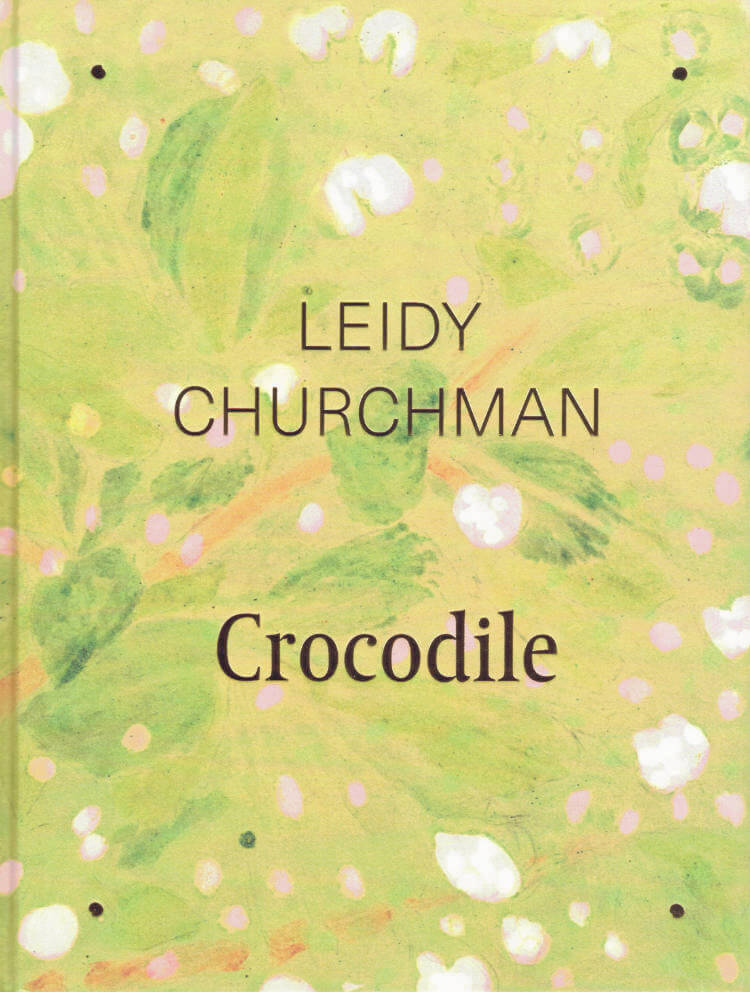
Crocodile
Ranging from figurative representation to gestural abstraction, monumental landscape paintings to more intimate portraits, the oeuvre of American painter Leidy Churchman (born 1979) channels his artistic and literary influences, friendships, moods, surrounding landscapes and the visual iconography of divergent religions and philosophies.
Crocodile highlights the artist's investigations into consciousness in his renderings of anthropomorphic animals and psychological states; his appropriation of existing artworks and aesthetics; and his recasting of various signs and symbols, from his depiction of the Buddhist symbol of the protector deity in Mahakala (2017) to the Mastercard logo in Mastercard (2013).
Churchman, who divides his time between New York and Maine, emerges here as a dynamic protagonist of contemporary American painting. In addition to collecting 90 reproductions of works, the book features artwork made especially for it, plus texts by Ruba Katrib, Alex Kitnik and Arnisa Zeqo, in addition to a conversation between Churchman and Lauren Cornell.
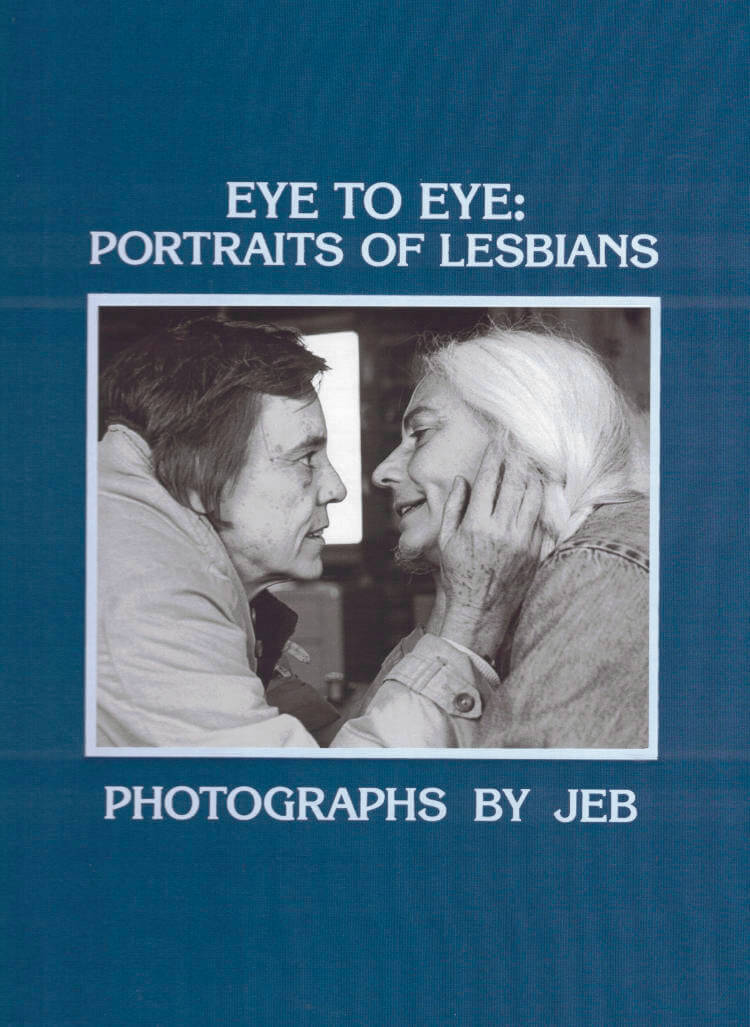
Eye to Eye: Portraits of Lesbians
In 1979, JEB self-published her first book, Eye to Eye: Portraits of Lesbians. In a work that was revolutionary for its era, JEB made photographs of lesbians from different ages and backgrounds in their everyday lives—working, playing, raising families, and striving to remake their worlds. The photographs were accompanied by writings from acclaimed authors including Audre Lorde, Adrienne Rich, Joan Nestle, and others. Various women pictured in the book also shared their personal stories. Eye to Eye signaled a radical new way of seeing, moving lesbian lives from the margins to the center, and reversing a history of invisibility. More than just a book, it was an affirmation of the existence of lesbians that helped to propel a political movement. Reprinted for the first time in forty years, Eye to Eye is a faithful reproduction of a work that still resonates today. This edition features additional essays from artist and writer Tee Corinne, former World Cup soccer player Lori Lindsey, and photographer Lola Flash.

Intourism
INTOURISM is the space of organised concentration, playing a story about how a man who has no identification documents travels the world. how he was banned from entering a country for life. how he’s got no clue what to do with that and then how he remembers nothing about it. it’s a tale of adventure, anything and everything he runs into during his travels. of course it’s meditative manipulation and a question of feeling; activation of inner civilisation by passion, by calming down or by nothing at all. the altering of text into a metaphor that defines man.
The play is published as two books, one in Estonian and one in English.
kadrinoormets: in december last year peeter rästas came to me with a proposal. the same evening I accepted it – we did not marry. I love rästas but not necessarily theatre – the same night I began to write, I prepared – the text ended up being dedicated to rästas. six months later I gave him a text set of a hundred to read and get to know – rästas wasn’t too excited about it, but I certainly was. rästas seemed sceptical, he approached it with the thespian distrust of abstract (body-)patterns within the formula of stagetext; in terms of understanding, of course. that distrust suited me, scepticism as sweet starting potential – I knew that it would pass – rästas hasn’t stopped.

Borrowing Positions
Borrowing Positions: Role-Playing Design & Architecture is a speculative book which reflects on the design- and architecture-centred LARPs (Live Action Role-Plays) organized by the Trojan Horse collective. The book is an exploration of Live Action Role-Play as a design and architecture research tool. By inviting the reader to try on different characters, switch roles and reconsider their everyday practices, the book explores issues such as identity, performativity, gender, colonialism, care responsibilities and fear in the context of architecture, design and urban planning.
The book consists of three parts: an overview of previous LARPs and their theoretical background; reflections (essays, visual essays and interviews) on LARP-related issues; and a practical (DIY) section – a step-by-step guide on how to organize your own design LARP.
Contributors to the book vary from architecture and design practitioners to performance artists working with role-play and fiction. The book will be of interest to anyone interested in inderdisciplinary practices in design and architecture.

Liturgy
A collage/text exploration of the overlap between healing, fiction, memory and ritual.
London-based Chinese Malaysian multidisciplinary producer and DJ Flora Yin-Wong presents her first book, Liturgy, a journey into the uncanny realm of the senses. Divided into nine chapters, the book delves deep into histories of healing and intuition. Reflecting the multilayered tonality of Yin-Wong's music, which often draws on field recordings and dissonant sounds, it interweaves textual and visual collage, divining inspiration from meditation, oracles, curses, divination, hexagrams and superstitions. Much like her music, which has been described as containing aural snapshots of places and sensations, Yin-Wong's Liturgy comprises a multitude of mediums. Reflected here is not only the multidisciplinary artist's approach to sound, but also her interest in the connection between fiction, memory, rituals and incantation.
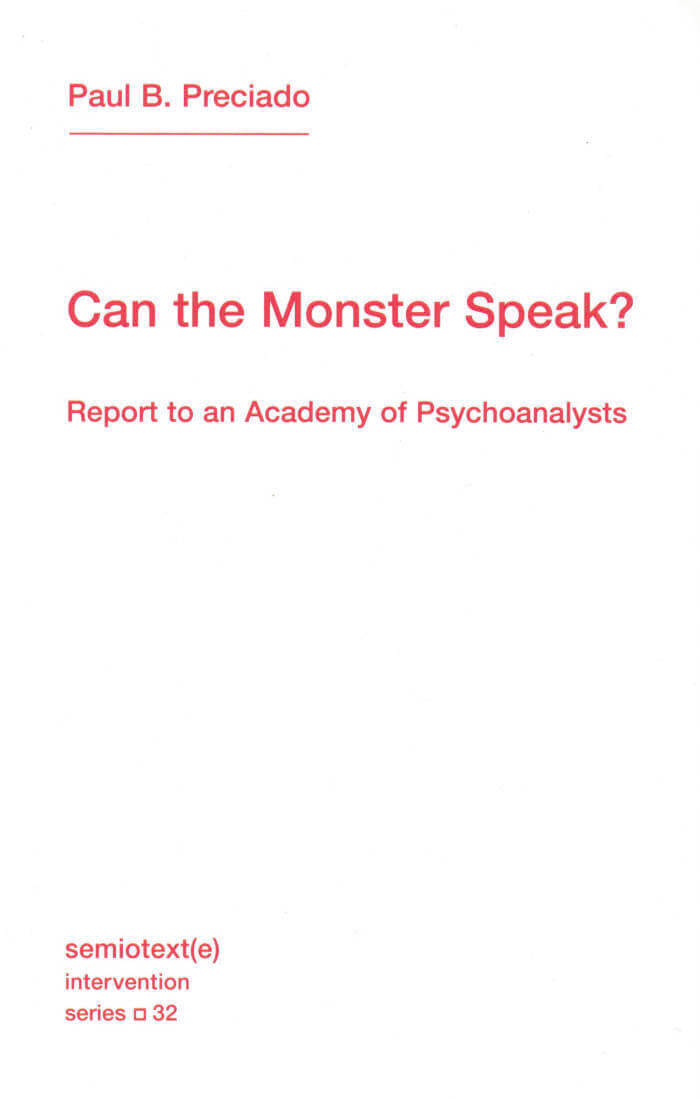
Can the Monster Speak?: Report to an Academy of Psychoanalysts
Paul Preciado's controversial 2019 lecture at the École de la Cause Freudienne annual conference, published in a definitive translation for the first time.
In November 2019, Paul Preciado was invited to speak in front of 3,500 psychoanalysts at the École de la Cause Freudienne's annual conference in Paris. Standing in front of the profession for whom he is a mentally ill person suffering from gender dysphoria, Preciado draws inspiration in his lecture from Kafka's Report to an Academy, in which a monkey tells an assembly of scientists that human subjectivity is a cage comparable to one made of metal bars.
Speaking from his own mutant cage, Preciado does not so much criticize the homophobia and transphobia of the founders of psychoanalysis as demonstrate the discipline's complicity with the ideology of sexual difference dating back to the colonial era, an ideology which is today rendered obsolete by technological advances allowing us to alter our bodies and procreate differently. Preciado calls for a radical transformation of psychological and psychoanalytic discourse and practices, arguing for a new epistemology capable of allowing for a multiplicity of living bodies without reducing the body to its sole heterosexual reproductive capability, and without legitimizing hetero-patriarchal and colonial violence.
Causing a veritable outcry among the assembly, Preciado was heckled and booed and unable to finish. The lecture, filmed on smartphones, was published online, where fragments were transcribed, translated, and published with no regard for exactitude. With this volume, Can the Monster Speak? is published in a definitive translation for the first time.
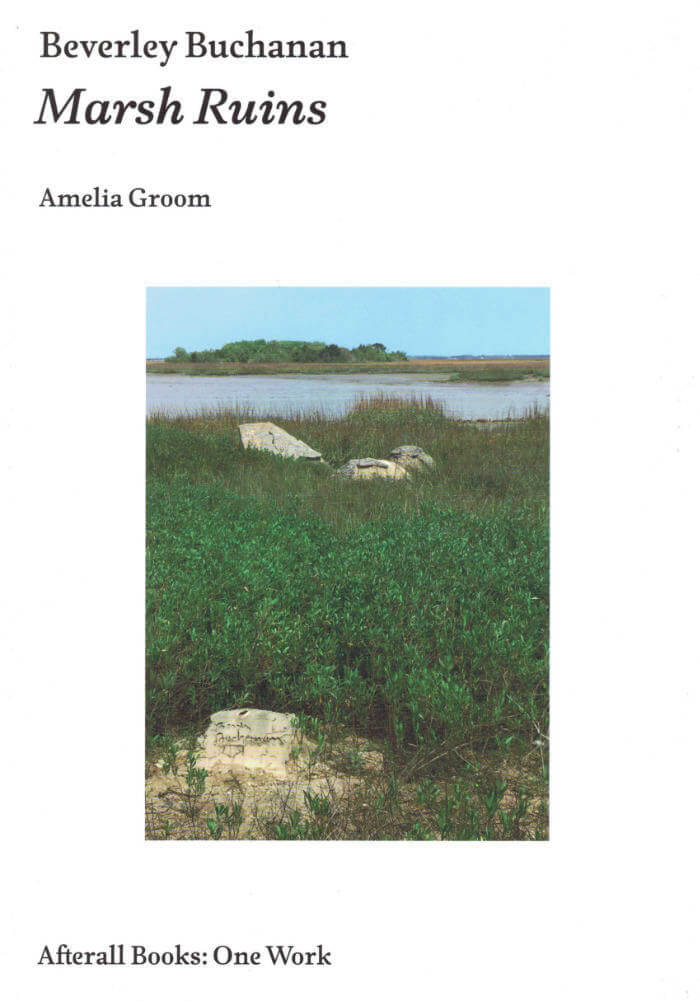
Berverly Buchanan: Marsh Ruins
An illustrated examination of Beverly Buchanan's 1981 environmental sculpture, which exists in an ongoing state of ruination.
Beverly Buchanan's Marsh Ruins (1981) are large, solid mounds of cement and shell-based tabby concrete, yet their presence has always been elusive. Hiding in the tall grasses and brackish waters of the Marshes of Glynn, on the southeast coast of Georgia, the Marsh Ruins merge with their surroundings as they enact a curious and delicate tension between destruction and endurance. This volume offers an illustrated examination of Buchanan's environmental sculpture, which exists in an ongoing state of ruination.
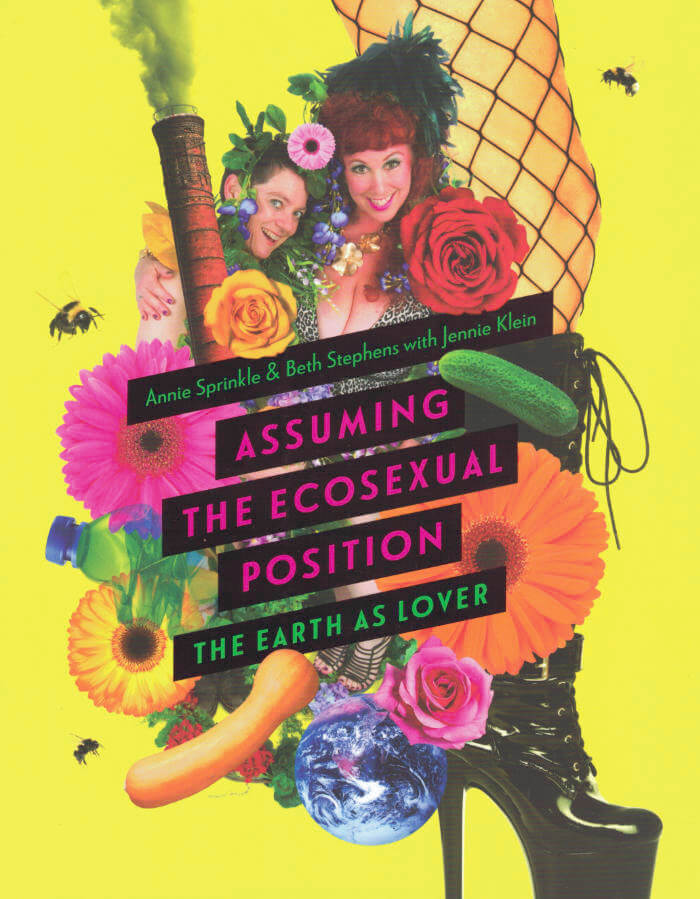
Assuming the Ecosexual Position
Annie Sprinkle, Beth Stephens and 1 more
The story of the artistic collaboration between the originators of the ecosex movement, their diverse communities, and the Earth.
What's sexy about saving the planet? Funny you should ask. Because that is precisely, or, perhaps, broadly, what Annie Sprinkle and Beth Stephens have spent many years bringing to light in their live art, exhibitions, and films. In 2008, Sprinkle and Stephens married the Earth, which set them on the path to explore the realms of ecosexuality as they became lovers with the Earth and made their mutual pleasure an embodied expression of passion for the environment. Ever since, they have been not just pushing but obliterating the boundaries circumscribing biology and ecology, creating ecosexual art in their performance of an environmentalism that is feminist, queer, sensual, sexual, posthuman, materialist, exuberant, and steeped in humor.
Assuming the Ecosexual Position tells of childhood moments that pointed to a future of ecosexuality, for Annie, in her family swimming pool in Los Angeles; for Beth, savoring forbidden tomatoes from the vine on her grandparents' Appalachian farm. The book describes how the two came together as lovers and collaborators, how they took a stand against homophobia and xenophobia, and how this union led to the miraculous conception of the Love Art Laboratory, which involved influential performance artists Linda M. Montano, Guillermo Gómez-Peña, and feminist pornographer Madison Young. Stephens and Sprinkle share the process of making interactive performance art, including the Chemo Fashion Show, Cuddle, Sidewalk Sex Clinics, and Ecosex Walking Tours. Over the years, they celebrated many more weddings to various nature entities, from the Appalachian Mountains to the Adriatic Sea. To create these weddings, they collaborated with hundreds of people and invited thousands of guests as they vowed to love, honor, and cherish the many elements of the Earth.
As entertaining as it is deeply serious, and arriving at a perilous time of sharp differences and constricting categories, the story of this artistic collaboration between Sprinkle, Stephens, their diverse communities, and the Earth opens gender and sexuality, art and environmentalism, to the infinite possibilities and promise of love.
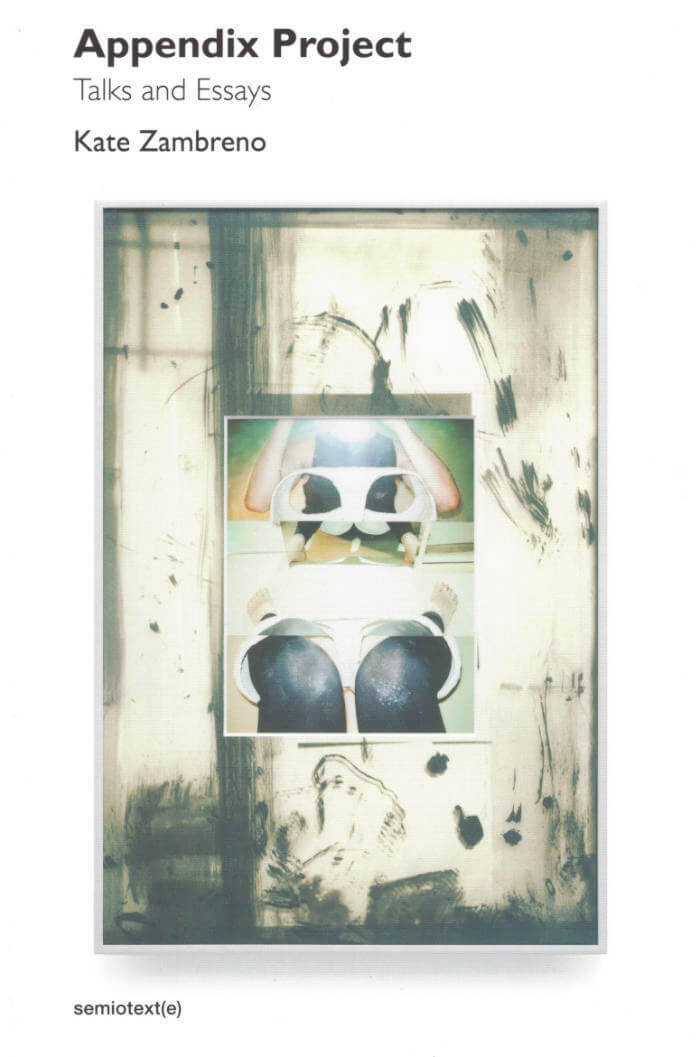
Appendix Project: Talks and Essays
Inspired by the lectures of Roland Barthes, Anne Carson, and Jorge Luis Borges, Kate Zambreno's Appendix Project collects eleven talks and essays written in the course of the year following the publication of Book of Mutter, Zambreno's book on her mother that took her over a decade to write. These surprising and moving performances, underscored by the sleeplessness of the first year of her child's life, contain Zambreno's most original and dazzling thinking and writing to date.
In Appendix Project Zambreno thinks through the work of On Kawara, Roland Barthes, W.G. Sebald, Bhanu Kapil, Walter Benjamin, Theresa Hak Kyung Cha, Marguerite Duras, Marlene Dumas, Louise Bourgeois, Doris Salcedo, Jenny Holzer, and more.